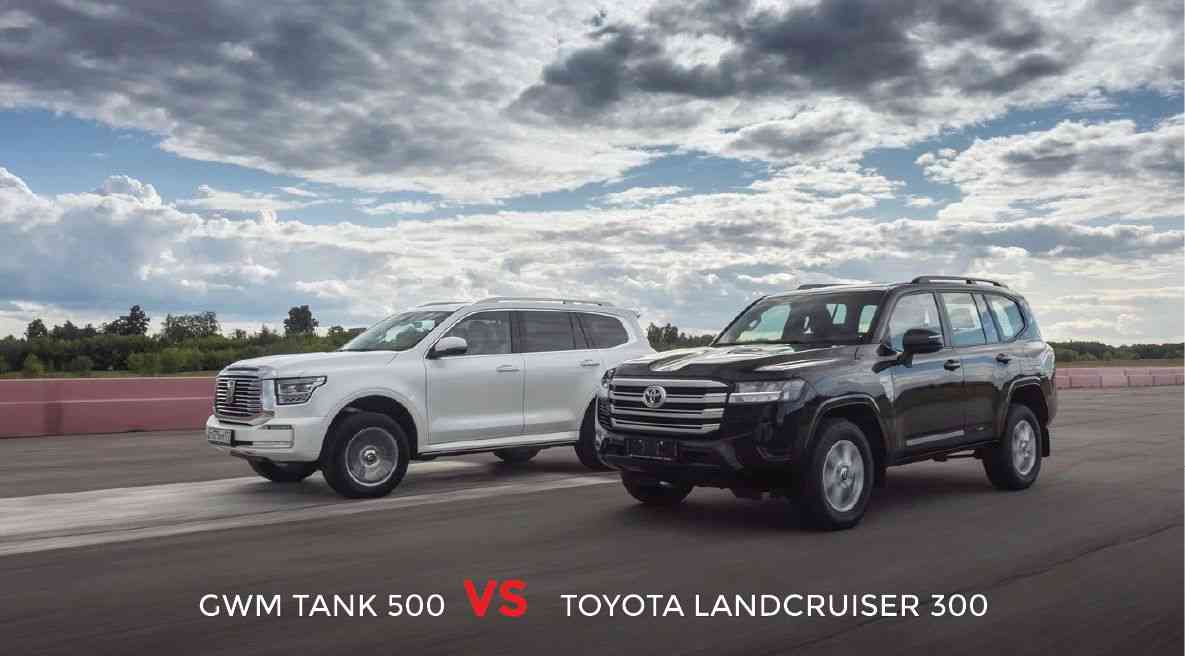
THE GWM Tank 500 article last week garnered derision from Toyota Land Cruiser 300 enthusiasts, as evidenced by the numerous emails and comments I received online.
Toyota Land Cruiser (LC300) is one brand with a massive loyal following as it is a trusted brand with a rich heritage. I refrained from drawing comparisons between the Tank 500 and the LC300 in my article.
However, I did say the Tank 500 would pose a threat and disrupt the establishment. Today, I decided to do a comparison because some readers requested that I do so.
I know it would have been prudent to compare it to the Land Cruiser Prado, but readers seem to be comparing it to the LC 300 series, so let me indulge them.
This considers the fact that there is a Tank 700 out there whose powerplant produces a total of 385 kW and 750 Nm, making it more powerful than any conventional SUV.
There is also a Tank 800 under development. We are in exciting SUV times. A fierce battle is brewing between two formidable contenders in the premium SUV market.
On one side, there is the LC, a legendary name that has long reined supreme in this segment. On the other hand, the Tank 500 emerges as a disruptive force, challenging conventions with its cutting-edge hybrid technology and impressive array of features. As these automotive giants compete, consumers ponder the age-old question: which one truly deserves the crown?
Exterior design: bold and imposing
- Motoring: Toyota Land Cruiser wins 2022 ZIMCOTY
- GWM Tanks invade Zim
- Clash of giants: GWM 500 VS Toyota Land Cruiser 300
- Chinese cars taking over roads
Keep Reading
Both the LC and the Tank 500 Hybrid exude an aura of ruggedness and dominance. These vehicles' muscular silhouettes and commanding road presence leave no doubt about their ability to conquer any terrain.
The LC boasts a robust and upright design, adorned with a massive chrome grille that demands attention.
Its dynamic auto-LED headlamps, complete with auto-washing functionality and sequential turn signals, add a touch of sophistication to its aggressive demeanour.
The Tank 500 displays its own bold and aggressive outlook. A prominent chrome grille graces its front fascia, complemented by auto-on/off LED headlamps with a follow-me-home function.
Both SUVs feature LED daytime running lights and front fog lamps, ensuring optimal visibility in all conditions.
The fight for luxury and comfort
The LC's interior exudes sophistication with its leather upholstery and three-way automatic, adjustable driver and front passenger seats. The driver's seat further enhances convenience with a memory function and powered lumbar support.
Not to be outdone, the GWM Tank 500 Hybrid raises the bar with its eight-way electronically adjustable driver's seat and six-way adjustable front passenger seat, both featuring memory functions. The Tank 500 Hybrid also boasts a larger 12,3-inch instrument cluster with light adjustment, compared to the LC's 7-inch TFT multi-information display and digital speedometer.
Dimensions and curb weight
The LC and the Tank 500 share equal dimensions in terms of overall length (1905 mm) and wheelbase (2850 mm). However, the LC's curb weight of 3230 kg gives it a slight edge over the Tank 500 Hybrid's 2810 kg, potentially contributing to its stability and off-road prowess.
Powertrain and performance
Under the hood, these two titans diverge in their powertrain philosophies. The LC 3.3D V6 GR-S stays true to its conventional roots, packing a 3,3-litre twin-turbo V6 petrol engine that unleashes an impressive 225 Kw of power and 700 Nm of torque.
A smooth-shifting 10-speed automatic transmission mates this formidable powerplant. Acceleration is 0-100 km/h in 6,90 seconds, with a top speed of 210 km/hour. In contrast, the Tank 500 embraces the future with its cutting-edge hybrid technology.
At its core lies a 2,0-litre turbocharged four-cylinder engine coupled with an electric motor, delivering a combined output of 255 kW of power and 648 Nm of torque.
A 9-speed automatic transmission channels this potent combination, ensuring seamless power delivery. Acceleration is 0-100 km/h in 8,3 seconds, with a top speed of 200 km/hour.
The tank has no pears
The Tank 500 Hybrid holds a distinct advantage in fuel efficiency. Thanks to its hybrid powertrain, it boasts an impressive mileage of 10–12 km/l, outshining the LC's fuel economy of 5–6 km/l.
This translates into significant savings at the pump and a reduced environmental impact, making the Tank 500 Hybrid a compelling choice for eco-conscious buyers.
When it comes to fuel efficiency, Tank 500 SUV has no pears in its league. Infotainment and connectivity In the digital age, seamless connectivity and cutting-edge infotainment systems are paramount. The LC impresses with its 12,3-inch touch-sensitive infotainment display, which supports Wi-Fi and Bluetooth connectivity.
However, the Tank 500 Hybrid takes a different approach, offering an 8.0-inch infotainment screen and a 6.0-inch display. Despite their smaller size, these screens aim to provide a user-friendly experience with abundant information and entertainment options.
Prioritising protection
Both the LC and the Tank 500 Hybrid prioritise safety by providing their occupants with a wide range of advanced safety features.
The LC comes standard with an SRS airbag system, six airbags, a security alarm, and an immobiliser. It also boasts cutting-edge technologies like ABS with brake assist, vehicle stability control, downhill control, crawl control, active traction control, terrain assist, rear cross-traffic alert, clearance sonars, and lane change assist.
Not to be outdone, the Tank 500 Hybrid offers six airbags, an immobiliser, a 360-degree view camera, and a security alarm as standard safety features.
Additionally, it introduces innovative technologies such as intelligent cruise assist plus off-road cruise control, rear collision warning, low- speed emergency braking, auto collision unlock, emergency brake warning system, up and down hill assist, automatic vehicle hold, collision cut-off system, pedestrian safety aid kit, and a driver fatigue monitoring system. When it comes to safety features, Tank offers more than the LC.
Off-road capabilities
Both the LC and the Tank 500 Hybrid are designed to tackle the most challenging terrains with ease.
Features like adaptive variable suspension, multi-terrain select, and crawl control bolster the LC's legendary off-road prowess, ensuring optimal traction and stability on even the most treacherous surfaces.
Meanwhile, the Tank 500 showcases its off-road capabilities with its intelligent off-road cruise control system, which automatically adjusts the vehicle's settings to conquer various terrains with ease.
Additionally, its advanced hill descent control and terrain response system further enhance its off-road performance. Pricing: A significant difference
While both the LC and the Tank 500 cater to the premium segment, their pricing strategies diverge significantly.
The top of the range
The LC commands a premium price tag of close to US$180 000. This substantial investment reflects the brand's heritage, reputation, and the vehicle's exceptional build quality and performance. In contrast, the Tank 500 offers a more accessible entry point into the premium SUV market, with a price tag of approximately US$85 000.00 locally.
This competitive pricing, combined with its impressive features and hybrid technology, positions the Tank 500 Hybrid as a compelling value proposition for buyers seeking a blend of luxury, performance, and affordability.
My decision
It becomes evident that both SUVs possess unique strengths and cater to different preferences and priorities. The LC upholds its legacy as a powerful and capable off-road warrior, boasting exceptional performance and a refined interior that epitomises luxury.
Its unwavering reputation and brand heritage continue to resonate with buyers seeking a tried-and-true premium
SUV experience. On the other hand, the Tank 500 emerges as a disruptive force, offering cutting-edge hybrid technology, impressive fuel efficiency, and a wealth of advanced safety and convenience features, all at a more accessible price point.
Some of the features, such as electric power steering (EPS), alloy rims, wireless charger, electronic brakeforce distribution EBD, auto defogger, remote windows/smart key open close, brakes fog lights, adjustable headlights/headlights levelling, side stepper, and much more, are not available in the LC.
Its blend of innovation, performance, and value proposition make it an attractive choice for those seeking a fresh perspective in the premium SUV segment. Admittedly, there is a certain level of swag that goes with saying, "I drive a Tank".
Ultimately, the decision between these two titans will come down to individual preferences, priorities, and budgetary considerations. Whichever path you choose, one thing is certain: the premium full-size seven-seater SUV market has never been more exciting, with these automotive giants pushing the boundaries of what is possible and redefining the driving experience for discerning buyers.
andrew@muzamhindo.com.






